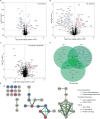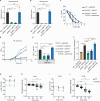The SPFH complex HflK-HflC regulates aerobic respiration in bacteria
- PMID: 40193326
- PMCID: PMC12005517
- DOI: 10.1371/journal.pbio.3003077
The SPFH complex HflK-HflC regulates aerobic respiration in bacteria
Abstract
The bacterial HflK-HflC membrane complex is a member of the highly conserved family of SPFH proteins, which are present in all domains of life and include eukaryotic stomatins, flotillins, and prohibitins. These proteins organize cell membranes and are involved in various processes. However, the exact physiological functions of most bacterial SPFH proteins remain unclear. Here, we report that the HflK-HflC complex in Escherichia coli is required for growth under high aeration. The absence of this complex causes a growth defect at high oxygen levels due to a reduced abundance of IspG, an essential iron-sulfur cluster enzyme in the isoprenoid biosynthetic pathway. This reduction might be related to lower stability of IspG and several other proteins, including the iron siderophore transporter TonB, in the absence of the HflK-HflC complex. Our results suggest that decreased IspG activity leads to lower levels of ubiquinone and misregulated expression of multiple respiratory enzymes, including cytochrome oxidases, and consequently reduced respiration and lower ATP levels. This impact of the hflK hflC deletion on aerobic respiration resembles the mitochondrial respiratory defects caused by the inactivation of prohibitins in mammalian and yeast cells, indicating functional parallels between these bacterial and eukaryotic SPFH proteins.
Copyright: © 2025 Pérez-López et al. This is an open access article distributed under the terms of the Creative Commons Attribution License, which permits unrestricted use, distribution, and reproduction in any medium, provided the original author and source are credited.
Conflict of interest statement
The authors have declared that no competing interests exist.
Figures




References
-
- Browman DT, Hoegg MB, Robbins SM. The SPFH domain-containing proteins: more than lipid raft markers. Trends Cell Biol. 2007;17(8):394–402. - PubMed
MeSH terms
Substances
LinkOut - more resources
Full Text Sources

